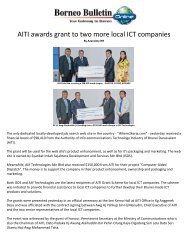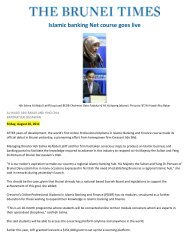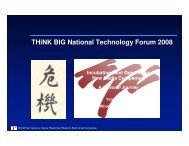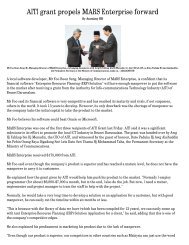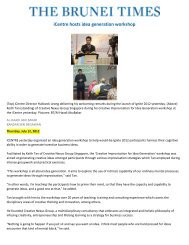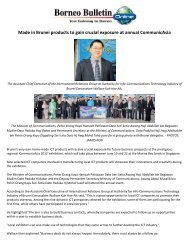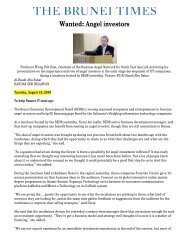EXECUTIVE SUMMARY: Writing a Impactful One Michael ... - iCentre
EXECUTIVE SUMMARY: Writing a Impactful One Michael ... - iCentre
EXECUTIVE SUMMARY: Writing a Impactful One Michael ... - iCentre
Create successful ePaper yourself
Turn your PDF publications into a flip-book with our unique Google optimized e-Paper software.
<strong>EXECUTIVE</strong> <strong>SUMMARY</strong>:<br />
<strong>Writing</strong> a <strong>Impactful</strong> <strong>One</strong><br />
<strong>Michael</strong> Reyes
1<br />
Attention Grabber:<br />
Start with the most compelling statement of<br />
why you have a really big idea.
1<br />
Attention Grabber:<br />
Work on <strong>One</strong> sentence (or two) that sets<br />
the tone for the rest of the executive<br />
summary.<br />
Make it a concise statement of the<br />
unique solution you have developed to<br />
a big problem.
1<br />
Attention Grabber :<br />
It should be direct and specific,<br />
not abstract and conceptual.<br />
If you can drop some impressive names -<br />
world-class advisors, multinationals you<br />
are already working with – you should
2<br />
The Big Problem:<br />
Make it clear that there is a Big, Important problem<br />
(current or emerging) that you are going to solve.<br />
In this context you are establishing your<br />
Value Proposition
2<br />
The Big Problem:<br />
Explain how you could:<br />
• increase revenues,<br />
•reduce costs,<br />
• increase speed,<br />
•expand reach,<br />
•eliminate inefficiency,<br />
• increase effectiveness
3<br />
The Solution:<br />
What specifically are you offering to whom?<br />
Use commonly used terms to state<br />
concretely what you have, or what you do,<br />
that solves the problem you’ve identified.<br />
Avoid acronyms and terms that won’t mean<br />
anything to most people.
3<br />
The Solution:<br />
Clarify where you fit in the value chain<br />
or distribution channels –<br />
who do you work with in the<br />
ecosystem of your sector,<br />
and why will they be eager to work with you
4<br />
The Opportunity:<br />
Explain in a few sentences –<br />
the basic market segmentation,<br />
size, growth and dynamics -how many people or<br />
companies, how many dollars, how fast the growth,<br />
and what is driving the segment.<br />
Provide clear and concise infomation
4<br />
The Opportunity:<br />
Remember:<br />
You will be better off targeting a meaningful<br />
percentage of a well-defined, growing market than<br />
claiming a microscopic percentage of a huge,<br />
mature market.
5<br />
Your Competitive Edge:<br />
No matter what you might think,<br />
you have competition.<br />
You either compete with :<br />
the current way of doing business,<br />
a near competitor or<br />
a direct competitor<br />
that is about to emerge .
5<br />
Your Competitive Edge:<br />
The “first mover advantage” is NOT<br />
a competitive edge many investors look up to.<br />
Here is where you can articulate<br />
your unique benefits<br />
and advantages.
6<br />
The Model:<br />
How specifically are you going to<br />
generate revenues, and from whom?<br />
Why is your model leverageable and scaleable?<br />
Why will it be capital efficient?
6<br />
The Model:<br />
What are the critical metrics on which<br />
you will be evaluated-customers,<br />
licenses, units, revenues, margin?<br />
Whatever it is, what impressive levels<br />
will you reach within three to five years?
6<br />
TYPICAL BUSINESS MODEL
7<br />
The Team:<br />
Why is your team uniquely qualified to win?<br />
Don’t try to impress by saying that you WILL have<br />
multiple experts with 45 combined years<br />
of expertise in your industry;<br />
Highlight instead that you have a specific person<br />
who has a specific and unique experience<br />
working in the industry
7<br />
The Team:<br />
Don’t copy-paste the CV of each founder ;<br />
explain why the background of each team<br />
member fits.<br />
If you can, state the names of brand name<br />
companies your team has worked for.
8<br />
The Promise & Rewards($):<br />
When you are pitching to investors,<br />
your fundamental promise is that<br />
you are going to make lots of money.<br />
The only way you can do that is if you can<br />
achieve a level of success that far exceeds<br />
the capital required to do that.
8<br />
The Promise & Rewards($):<br />
Your Summary Financial Projections should<br />
clearly show that. But make it believable<br />
You should show 3-5 years of r<br />
evenues, expenses, losses/profits,<br />
cash and headcount..
9<br />
The Ask:<br />
This is the amount of funding you are<br />
asking for now.<br />
This should generally be the minimum<br />
amount of equity you need to reach<br />
the next major milestone.
9<br />
The Ask:<br />
You can always take more if investors<br />
are willing to make more available,<br />
but it is hard to take less.<br />
If you expect to be raising another<br />
round of financing later, make that<br />
clear, and state the expected amount.
SOME GENERAL POINTS<br />
TO KEEP IN MIND
1<br />
Do not lead with broad, sweeping<br />
statements about the market opportunity.<br />
What matters is not market size, but rather the<br />
size of the problem you are solving.
2<br />
Don’t acronym your own name.<br />
Sun Microsystems did not build its brand by<br />
calling itself “SMI.<br />
Drop names, if they are real; don’t drop<br />
names if they are smoke.<br />
If you have a real partnership with a brand name<br />
company, don’t hide it. If you consulted for<br />
Cisco’s HR department one week, don’t say<br />
you worked for Cisco.
3<br />
Avoid “purple smoke”—adjectives that sound<br />
impressive but carry no substance.<br />
“Next generation” and “dynamic” probably don’t<br />
mean anything to your readers<br />
Explain your company the way you would to a<br />
friend at a party
4<br />
State your value proposition and<br />
competitive advantage in positive<br />
terms, not negative terms.<br />
It is what you can do that is important,<br />
not what others cannot do. With the one<br />
or two most obvious competitors,<br />
however, you may need to be very<br />
explicit. Use simple sentences, not<br />
multi-tiered compound sentences.
5<br />
Use analogs, as long as you are<br />
clarifying rather than hyping.<br />
You can say you are using the Google<br />
model for generating revenues, as long<br />
as you don’t say you expect to be the<br />
next Google<br />
Go back and reread each sentence<br />
when you're done:<br />
Are they clear, concise and compelling?
6<br />
Finally, one of the most important sentences<br />
you write will not even be in the<br />
executive summary-<br />
it is the sentence that introduces your<br />
company in the email that you send along with<br />
the executive summary






